|
|
 |
|
|
|
|
|
|
|
|
|
||||||||
|
|
|
|
The American Muscle Car What is it?
You don't want a stodgy four-door sedan, a copy of the Mustang, or a normal go-to-work hardtop. You're after something more, something you can d-r-i-v-e with a capital D. You want something you can put the wife and kids in, cut out over the mountains down into the desert, swing down ninety miles of freeway through the city to the beach. You want to drive quickly, in control and comfort. Right? Fine, you've just tabbed yourself a potential Muscle Car owner. Oops, there they go: the guffaws, the insults, the prejudice from those among us who have found THE TRUTH --- and it didn't come from Detroit. YOU, my friend, have just tabbed yourself a NUT in their minds, limited and narrow-minded as the case may be. Our recommendation if you must persist in this madness is to forget them and their cries. Touch your finger gently to the power window switch and close them off. Slip Sinatra on the eight-track stereo and cool the scene with the ice. Shift your automatic transmission into 1st, stand on the go pedal, upshift through your two remaining gears, run away and hide from them in the mountains. They won't listen to you nor will they change their opinions. As far as they are concerned you are driving the dirtiest of dirty words: DETROIT IRON. Does that sound appealing to you? Bit of a rebel are you? Read on. Just what is a Muscle Car? Exactly what the name implies. It is a product of the American car industry adhering to the hot rodder's philosophy of taking a small car and putting a BIG engine in it. To balance this out, handling, braking and related essentials are modified to result in a performance machine for the streets. They tack racy names to the car: GTA, GTO, GTX, or just plain GT; R/T, SST, SS, GS or, for the lack of better initials, 4-4-2. They doll the car up with fancy trimmings and put it up for sale. And it sells like crazy. It is part and parcel of America's unending quest for youthfulness. It is a sexy car, in the Detroit sense of the word, though some of the cars lean toward the Rubenseque rather the Hefnerian. But, most of all, the Muscle Car is Charles Atlas kicking the sand in the face of the 98 HP weakling. It is the American man's answer to Susan B. Anthony, Wally Cox and Don Knotts reign supreme and Woody Allen can go home again. ROAD TEST Magazine has had much experience with cars of this caliber. We have been enthusiastic about these machines only when a well-balanced model came along---and there have been FEW of those. Our basic feeling has always been that the cars GO very well, HANDLE very well, but need the Queen Mary's anchor to STOP. The current crop of M Cars still fits that description with the exception that, for some, a yacht anchor will suffice but the others need an aircraft carrier's. The Pontiac Motor Division started the M Car Revolution as we know it. Since then nearly every manufacturer has brought out their version. We thought it would be worthwhile to test all of these cars, pitting one against the other, and accepting no alibis for our findings. To begin, our staff took deliver of nine cars. Alphabetically, a Buick GS 400, Chevrolet SS, Comet Cyclone GT, Dodge R/T, Fort GTA, Oldsmobile 4-4-2, Plymouth GTX, Pontiac GTO, and a Rambler Rebel SST. All but the Chevy SS have automatic transmissions. All were hardtops except the 4-4-2. Some of the staff find it difficult to distinguish the cars since they are all so similar. It should be pointed out that the Muscle Car, outwardly, varies little with its sister models. They are all versions of separate models, I.E., the GTO is a Tempest, the Buick GS 400 is a Skylark, the Fort GTA is a Fairlane, etc. The M Car option is, in essence, a package. It consists of a hotter engine (one or more offered), a different transmission (though the same boxes can be ordered on regular models), heavy-duty semi-racing suspension, special wheels and tires, and trim for interior and exterior identification. That is about the gist of it. Specifics vary from car to car, manufacturer to manufacturer. What is important to remember is that these are not separate, original cars. The idea of modifying a model with options to meet the demands of a certain segment of the car-buying public started in the U.S. but it has spread to other countries. Porsche's 911S and Rover's 2000TC are current examples. Yes, Virginia, hotter engines, better handling gear, special trim and wheels, etc. Finally, forget the idea that you're buying a 185-MPH NASCAR stocker. The M Cars resemble Junior Johnson's chariot as much as a Fairlane wagon compares to the Jimmy Clark Lotus-Ford. Meanwhile, let's forget about the purist's idea of an automobile --- you know, miles of racing heritage, millions of gauges, loud transmission whine, louder exhaust, rattling body panels --- and get on down the road. Put Sinatra back on the stereo, turn on the air-conditioning, speak quietly with one another (no need to shout in these cars), and mind the Police Car behind. |
|
|
|
Some good ideas
on... SHOPPING FOR MUSCLE In preparation for the tests in this issue we assigned a staff member to visit dealer show rooms of all the models due for testing. The purpose: to learn what you, mister buyer, might expect when you decide on the model of your choice. In reviewing our findings, the most outstanding characteristic was the predominant ignorance of the cars displayed by two-thirds of the salesmen talked to. Only Buick, Olds and Pontiac sales people demonstrated considerable knowledge of the cars, the performance options and what was installed on the cars on display. Of the dealers, only two salesmen volunteered the information that we might save money off the windshield stick price. These were Pontiac, offering approximately an $800 saving off list and Ford offering a $650 discount. Nine showrooms were visited and none made a serious effort to switch us off our announced interest in the $4,000 GT package. The Chevrolet salesman, who incidentally was the only one who approached the old fashioned "hard sell" manner, tried half-heartedly to swing us toward the Camaro. None pushed hard to get us to take an immediate demonstration ride. A striking difference prevailed in the immediate availability of all the options in which we expressed an interest. Our first stop was at the Plymouth dealer. Circumstances here were not really fair, for the dealership had very recently changed hands and the sales staff was woefully new to the line. Our questions were answered courteously but only by reference to the brochure specifications as to availability. None of the cars on the lot had all of the performance options we inquired about. Time lag quoted to take delivery on a car with all we expressed interest in (disc brakes, four speed manual shift, limited-slip rear, wide oval tires, heavy-duty suspension and air conditioning) was five to six weeks. We next visited an American Motors dealership where we were shown the Rebel. Here a car was available with all our supposed desires with the exception of four-on-the-floor and limited slip, we were again quoted a wait of about six weeks. The salesman, unfortunately a bit hard of hearing, made quite a thing of the seven position "tilt-away" steering wheel. (We had asked about the availability of a steering wheel adjustable for distance.) At our Pontiac dealer we first had a bit of trouble locating an interested salesman but once in tow were shown every courtesy. There was little trouble here regarding our having all the goodies we wanted on our GTO until the subject of big engine came up. Then things bogged down. If we wanted the "ram -jet" there would be a 60-day delay. Once the list price of approximately $4,400 was established we were assured that the actual delivery price would come to about $3,600. Our next visit was to the nearby Mercury dealer where a feeling prevailed that the conservative staff was a bit suspicious of the performance line. However, by asking the right questions we were assured that we would be able to get a Cyclone GT with all the options we desired within a maximum of 10 days. A few blocks away we dropped in at Dodge to look over the Coronet R/T. This was one of the few dealerships to demonstrate real pride in their latest entry into the Hot One category. The salesman, while young and enthusiastic, was not irritatingly aggressive. Here also we found the first interest in our trade (an import) and what appeared to be a sincere interest in getting the best possible deal. Availability was immediate for everything but the manual four speed transmission and for this option we were quoted about three weeks. Chevrolet and Chevelle SS 396 was our next destination and for a time we felt like it might also be a sentence. The salesman had NO cars on the floor to show us, but he did have a Camaro and after the mild effort to switch us pointed out the similarities and differences. To give him credit he did know the line, did know the options and was overly-eager to list them for us, with prices, at considerable length. We finally escaped after learning that maximum delay for a car with everything we wanted would be about three days. At our Buick dealers we were quickly shown the GS-400 and on the showroom floor were two cars with all the desired options except the four-speed shift and the limited slip. It seems odd but only once salesman attempted to tout us off the stick shift, even though it shaved the price by up to $100. This was the Dodge salesman who correctly pointed out that the clutch with a manual shift was not covered in the 5-year warranty. But back to Buick where we could expect delivery with everything of our choice in about three weeks. Ford was next on our itinerary and here the GTA we were shown was a virtually stripped model (or so the windshield sticker would make it appear) then we learned that many of the options that are extra price items are standard on this model. Limited slip and air-conditioning would be all we'd have to order. But delivery time would still be five weeks. The Ford salesman was the second to volunteer information on a price discount off the window sticker. With air, the list price would come to approximately $4,200, but with a $650 discount the price would fall into line with the GTO. Our final call was made at the Olds dealer where we saw the 442. Both a sports coupe and a convertible are offered in this line. While neither of the two cars on the lot had all of the goodies we claimed to want we were assured this posed no problem since dealer cooperation would surely turn up exactly the car with exactly the options within 48 hours, color excepted. Here we were agreeably impressed with the salesman's knowledge of his cars and availability of options. In conclusion it is evident that the buyer, at least at the time of the writing, can definitely write his own ticket so far as the equipment he wants on his car, providing he is, in many cases, willing to wait anywhere from a day or two for up to two months. We have seen also, that window sticker prices may be relatively meaningless. We dropped in off the street, knew no one, and yet were voluntarily offered discounts on two cars, one a GM, the other a Ford product. Apparently you can wheel and deal when you decide on what you want and what you want it on. |
|
|
|
|
|
|
Easter
eggs from the same hatchery
Oldsmobile 4-4-2
Comet Cyclone GT
Pontiac GTO
|
|
|
|

|
|
||||||||||||||||||||||||||||||||||||||||||||||||||||||||||||||||||||||||||||||||||||||||||||||||||||||||||||||||||||||||||||||||||||||||||||||||||||||||||||||||||||||||||||||||||||||||||||||||||||||||||||||||||||||||||||||||||||||||||||||||||
|
|
Performance and Roadability The Domestic Sports
Sedan The term 'Sports Sedan' is not one that you'll find bandied around in your friendly neighborhood dealer where the domestic version is found. Rather it is Madison Avenue boys' jargon which extols the virility aspects of the shape and a few magic (or meaningless) letters which are supposed to send the buyer into spasms as he feverishly reaches for his check book to slap down the necessary cash to let him unleash one of these Juggernauts on the highway.
We have looked at these mammoth machines before, or specifically three from the GM stable; and the memory of the older testers is forever green when they recollect the moments of excitement experienced when trying to control, maneuver and stop those cars under what could best be described as 'traumatic situations' on private roads where we had room to roam. The main criticisms at that time referred mainly to brakes, steering and suspension. For readers who are unfortunate in not having read the tests, the general comments were that there was too little braking in any of them, suspensions were very much of the rubber band and marshmallow variety and the steering had the gearing ratio of the Queen Mary. Two years have elapsed since those tests and some new blood has been added to the staff, coupled with a plentiful supply of brave pills, it was felt that the time was right for another critical look at the latest from Detroit. This time, GM were not on their own and we have the whole gambit from all the manufacturers. We again limited our choice of cars to the $3500.00 to $4500.00 price range and this covers all the domestic offerings with a certain amount of leeway nearer the top end of the scale. Performance and
Handling Pounds Versus
Horsepower The power-weight ratios of the cars show up well when compared with the lesser figures of the imports. How Sporty? Certainly all the cars tested have lots to offer in space and luggage room for the family on a long trip. However, the seats generally do not compare favorably with the import from the fatigue aspect and thereby nullify the advantages gained by basically having a larger car where greater creature comfort could have been better utilized. Furthermore, the average buyer will not be familiar with the basic parameters of a sports sedan per se and therefore our testing allowed for the fact that the prospect for the car will not necessarily be familiar with cornering techniques, handling and maneuverability. It has been assumed that he will probably try a few fast accelerations and perhaps a modest attempt at a panic stop coupled with a few sweeping curves at speed. Under these circumstances what sort of difficulties, if any, will he encounter with these cars? All of the subject cars are equipped with power steering as a standard item with the exception of the Chevelle. Unfortunately, power steering offers the driver the same amount of wheel movement for parking the car as it does for changing direction regardless of the speed of the vehicle. This is a dangerous situation as in emergency, in a skidding situation, the driver has no knowledge of what is happening up front and exactly where his wheels are pointing. However, cars fitted with the wide oval tires helped the feel of the road through the wheel to the driver and have gone a long way towards giving some steering response more commensurate with what would be ideal for cars of this size and weight. At the risk of appearing to favor European systems, it is worthy of note that Jaguar sedans use a system that lowers the power requirement as speed increases to a point at around 70 mph, the response is almost similar to that of rack-and-pinion steering. The heavy car requirement for power steering in the first place is for parking only. With the Jaguar system, it provides exactly the same response as does the American sedan. The system that we have described was developed by Jaguar and Bendix and is probably going to be introduced into Detroit in the future. All of the cars are equipped with the heavy-duty suspensions, sway bars up front and disc brakes except the Rebel and Chevelle, which had drums. With these items, the cars give a reasonable facsimile of control and show that they have certainly come a long way in the past two years as regards handling by Detroit standards. They still fall a long way behind the European offerings in this respect, mainly because more skill is required to corner them at speed and there is little in the way of forgiveness should the driver make an error of judgment. This in turn is accentuated by the vast dimensions of the machines. The best handling car, by a unanimous vote, is the Dodge, but only by a very small margin over the Ford. The Dodge was given the edge in that it handles as well as the Ford despite the fact that the Ford is equipped with the wide oval tires as standard whereas the Dodge achieves the sure-footed cornering ability without benefit of similar rubber. The Cyclone follows closely behind these two and the Plymouth behind this. In the middle of the pack you'll find the GTO, Olds and Buick with the Chevelle and the Rebel vying for the bottom. The Rebel has one of the smaller V-8's, so small in fact, it feels like a six. The power steering also feels worse on it than any of the others, so consequently it was bottom for two reasons at this stage. The Chevelle does not have power steering as standard and is particularly nose-heavy going through the corners to such a degree that all testers comments were punctuated with many religious references and parental aspersions at the men responsible for it's design. Summary The Rambler is also a handful on the corners, mainly due to the twitchy feel of the power steering and a slightly softer spring rate compared to the other cars.
|
 Mercury handled similar to Ford GTA and would have been equal to it had it not been for the M. Mouse transmission in the Cyclone GT.  A hump just before the fast turn heading down the long curved straight gave suspension a workout. Here, the Merc takes the turn in good shape.  Handling faults were few and M Cars could lap Willow Springs course very fast. Dodge, Ford, GTO and Comet were best handling, in that order. 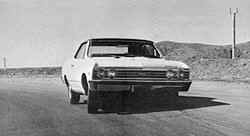 Chevy SS felt like it would go into orbit at any minute -- whether the driver wanted it to or not! Consensus was too much engine for too little handling. 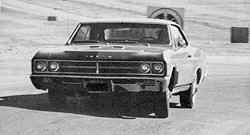 Buick GS 400 would sometimes plow around the course. Lack of feel with GM steering plagued all of the GM cars tested. 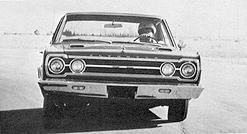 GTX suffered body lean at great speed and did not handle as well as the engine performed. Many felt it was a tricky car because of the easy rear end breakaway.  Suspension seemed stiffer on the Dodge as it put the big 440 engine's power on the ground in a more acceptable manner. It was the best car. 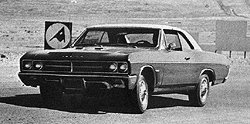 The Buick wallowed all over the course and was hard-pressed to stay on a line. This was a case where the handling was not up to engine's power. 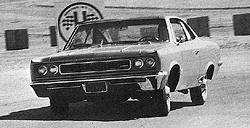 Rebel did not have what it takes to lap the Willow course at speed. Distance between accelerator and brake pedal took a lot of getting used to and was too much. 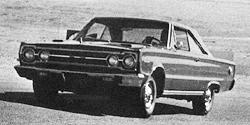 GTX certainly had the potential, but was not the faster car on the handling test. Flimsy suspension was blamed; wide oval tires would have helped, too. 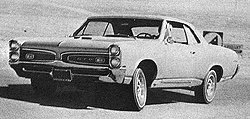 Special lock-out Hurst quadrant on GTO enabled drivers to manually change gears. Best was keeping it in second all 'round and shifting into third on straightaway. 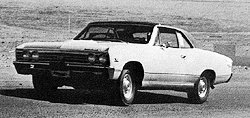 Chevy was evil handling. Slight touch on the throttle would bring the rear end around -- predictably, yes, but there was no need for it. |
|
|
|
|
|
|
||||||||||||||||||||||||||||||||||||||||||||||||||||||||||||||||||||||||||||||||||||||||
|
|
BRAKES AND SAFETY FEATURES Long on Go...Short on Whoa Brakes Brake fade is apparent in all the cars, even those with disc brakes. This was quite illuminating when the weights of the cars are compared with those of the Jaguar and Mercedes of our previous test. The number of times the rear wheels break loose are too numerous for comfort and it is felt that these cars in the hands of inexperienced drivers would give them handling problems they would be unlikely to solve just before they handed in their dinner pails; not exactly the best time to try improving one's driving skill. |
|
|
|
 And there it goes, into the wild blue yonder -- as the Chevy fails its braking tests and carries crew into the tullies for impromptu boondocking. |
 Pontiac GTO stopped best of all the GM cars. It, too, got a bit sideways, but came to a sure stop in less distance than the Buick, Olds or Chevy. |
 Buick GS 400's front disc brakes did not stop the car in anything that could be considered a safe distance. Cause might be excessive weight. |
|
|
|
 The Plymouth GTX with ostensively the same brakes as the Dodge did not lock up its wheels but took greater distance to stop with better stability than Dodge. |
 Dodge R/T, although it stopped in the shortest distance, locked up and got sideways in brake tests. Driver had to ease up on pedal to get straight. |
 Speeding on the wings of Mercury, the Cyclone GT stopped very well. It was 2nd best, giving up distance for stability, so it could be tagged best braking car. |
|
|
|
 Olds suffered from braking tests, managed to get itself all locked up and slide its wheels. Extra weight of convertible didn't help anything either. |
 Rambler Rebel was average for American cars (no pun intended) and did not score well. Driver probably would have hit target in this car. |
 Ford GTA surprised everyone in brake tests, responded well. Initially it faded but then improved. Brakes did not lock-up nor did they smoke. |
|
|
|
|
|||
|
|
|
|||
|
|
Safety
Features These cars reflect the first production vehicles to have some of the new Federal Safety Requirements built into them. They range from padded steering wheels, padded dash, collapsible steering columns; to front and rear safety belts and outside mirrors. Picking an item from each car will suffice to give a general picture which can almost be applied to cover nearly every car to a certain extent. The Dodge has an extremely narrow padded dash with a large amount of stainless on the lower portion of the dash. There is also an excessive amount of stainless steel on the tunnel which can cause unexpected reflections when maneuvering the car. The windshield posts are also stainless and again it is felt that they tended to increase the glare when least expected. The tachometer was located on the tunnel and if the driver spends any time looking at it he might never know what hit him. Location of the outside mirror is good with approximately only 50 percent of eye movement being required to view it. This is certainly an acceptable figure. The door handle release is one of the safest in use and requires a positive grip to open. It can't be accidentally moved. One feature which was criticized is the speedometer. The figures are too crowded in the middle speed range and therefore very difficult to read at a glance. The Ford GTA has a well-padded dash at the top part but is overly decorated in the lower section, rather like a jukebox in a roomful of Chippendale. The windshield posts are padded with a matte-finished material which definitely rates a plus mark. The outside mirror is placed in an awkward position for short drivers who sit well forward. It necessitates their turning their head through 70 degrees to be able to see behind. This was felt to be too much. The warning lights are offset to the left of the dash; they would have been better situated towards the center of the instrument panel. The Olds has a circular speedometer and matching tachometer but the usefulness of the tachometer is questionable due to it being the center piece with four other gauges surrounding it with confusing results. The top of the padded dash in all the GM cars sits quite high and, coupled with the heavy tint to the upper portion of the windshield, makes the forward area of visibility quite narrow in depth for small drivers. The effective viewing area of the windshield is reduced by at least one third. The GTO has a very legible speedometer but with this car, it could have used a good tachometer in place of the clock. The air conditioning effluxes present a hazard to the drivers and passengers knees in the event they do not have the seat belts in position. The Buick suffers from exactly the same complaint plus the ignition key position which will most certainly get the right knee cap. This car also has the outside mirror positioned too far to the rear. The Plymouth speedometer has calibrations in 10ths, which unnecessarily cluttered up what could be a legible instrument. It also suffers from too much chrome on the dash. The Cyclone is one of the best as regards combination of instruments, and dash with good padding and recessing of knobs. The center padding on the wheel is considered more of a gesture than a practical safety feature but without actually sampling it under crash conditions, it is difficult to say just how effective it would be. The Chevelle dash is padded on top only, with a heavy amount of metal opposite the driver and passenger knees. The speedometer has the figures too close together making it difficult to read in a hurry. The Rebel offers poor protection for the driver's knees although the passenger fairs quite well in this respect. One bad feature is the height of the brake pedal in relation to the throttle. Even if the left foot is used for braking, it has to be lifted almost eight inches before it can be put on the brake pedal. The Rebel does offer a center arm rest but it is set at a higher position than the one on the door and if the driver attempts to use them on the road, the uneven heights tend to cause a leaning posture to the left which is extremely tiring on a long trip. The seats on the car are adjustable for rake, which at first glance, is a desirable feature. Unfortunately, the three positions are so widely spaced that they are virtually useless; the upright position is too straight and the next position has the driver looking at the roof, there being no intermediate stop in between. It might be useful for drive-in movies but doesn't seem to be suitable for much else. The reclining position is just that... The seating in all of the cars nowhere approaches the high orthopedic standards of those found in the imported sedans. The GM seats are all basically the same and the cross-section of the backs represents a 'V' cut. No human is quite shaped that way and therefore the seats are not comfortable over a long period of time. They offer little in the way of lateral support and without seat belts, the driver slides around to an alarming degree. None of the seats have any form of armrest built into them and this is almost a must for a car with a touring capabilities. The quality of material for the seats is basically vinyl and will obviously give good service. The Rambler seat is of the cloth variety reminiscent of bygone days when such material offered the durability of a wilted lettuce leaf. Our 5'6" Scot could not adjust any seat to provide long arm steering as his feet couldn't reach the pedals. Either an in/out steering wheel or reclining seat back would have been appreciated for small drivers. |
|
|
|
|
|
||
GM designs its cars so that end
of fender |
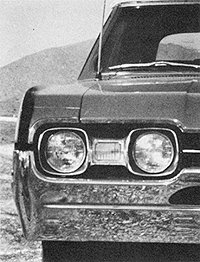 |
|||
|
|
|||
|
|
Summary
Are they worth the money? Each of these cars does offer certain advantages over the import in that the window dressing gadgetry is easily added and can make for pleasant creature comfort items at moderate cost. We refer to air conditioning, power windows, power seats, tape decks, etc., all of which make pleasant interior conditions and as such must be rated as a safety feature as anything that makes for driver comfort and fatigue reduction is to be desired. However, to concentrate on those luxury items at the expense of handling and performance equipment is unforgivable. To perpetrate a thirty-year-old suspension system on the buying public is an outrage of the first magnitude. To couple that to a weak braking system only compounds the felony. That the cars will sell, and sales do prove this point, is only a testimony to the advertising agencies. For a buyer who is not an enthusiast, or takes no particular pride in his motoring skills; then any one of these machines will certainly satisfy his needs provided he drives it at highway speeds and never has cause to make more than one panic stop in a day. The danger to such a buyer is to be confronted with a maneuvering situation such as when trying to avoid an accident; this is when he will experience the moment of truth. The driver who prides himself on his knowledge of cars and their handling can buy one of them and with careful selection of the options available, probably get close to a satisfactory vehicle that would pass in a crowd but would be easily eclipsed in every respect by any one of the imported cars that were tested in our previous issue. With the continual yearly model change, the buyer never really gets tired of the car as he can always get the 'latest' offering by walking into a dealership. As we have seen, this is invariably a facelift with the same old framework underneath. Now that there are new safety requirements being issued, it is to be hoped that the engineers will be given an opportunity to show what they can do and we would then be in the exciting position of having the handling and performance of the cars match up with the frills that are already installed and which do have a place in the overall picture but not at the expense of the basic requirements to give the driver a better tool to use on the highway. |
|
|
|
|
Comfort and Convenience In General Seat adjustment, fore and aft, is excellent. However, not one manufacturer offers steering wheel adjustment to compliment. A six footer, with seat in proper position to manipulate the throttle and brake, will find the steering wheel too close for sustained comfort in any of these cars. Can it be that a splined steering column, with fore and aft adjustment, is beyond the engineering capabilities of Detroit? Or is it that frightfully expensive? While on the seating/steering subject, we found the seat back adjustment for rake astonishing in most examples. We were offered upright, tilted and supine. In the latter position, we were afforded an excellent panorama of the headliner. Rear seat entry is uniformly difficult. Rear seat exit is uniformly impossible (well, almost). Only two of these cars offer adequate leg room behind a six foot driver; the Plymouth and Dodge. Only GM products provide locks on the front seat to keep the seat back from flopping forward on a hard stop. The convenient push button can be operated from the rear seat or outside the car. Four-way flashers, an excellent safety device, are offered on some, but not all models. Eight of the nine cars have automatic transmissions. For driver convenience, our ROAD TESTers preferred the console (floor-mounted) quadrant to the steering-column mounted. Interior finish is uniformly good. All except the Rambler offer simulated leather upholstery. The Rebel has a rather garish combination of plaid fabric and matching plastic. Also on the plus side, all cars have tinted glass windshields that produce little or no distortion at the posts. There are individual problems and good points, lets take them up one by one. Dodge
R/T
On the debit side, the front seat center console cover must be attached -- we use the term loosely -- with undersize sheet metal screws. This compartment is very busy with an assortment of rattles and shakes with accompanying high noise level. On refinements for the effete, there is an inside adjustment for the outside rear-view mirror. Inside door handles are flush with armrests, not only good for safety in an accident but also, pulling out, rather than up, doesn't tempt a panicky passenger to open the door at speed. However, the window winder, just so your knee won't get lonely, is ideally located to bruise that tender member. Another charming feature: if at full throttle you have occasion to lift your right foot to go for the brake, you might wonder why you still go so fast. What has happened is that your shoe sole has snagged the tunnel carpet and you're still at 3/4 throttle. Plymouth
GTX By employing the column shift rather than the console, Plymouth designers have made a form of compromise with their bucket seats. A solid divider between the seats forms an almost bench seat for three persons on short trips.
Door handle and window crank are very similar to the Dodge installation with the same good and bad points. The Plymouth employs a novel driver turn indicator signal, small lights mounted atop each front fender. The one on the left is readily visible but the right indicator is out of sight to the average driver and the indicator click is inaudible with the radio playing. These indicators however, also serve to give the driver the approximate location of his front wheels. Our ROAD TESTers feel the steering wheel position is too high for comfort and brake pedal too small for those accustomed to left foot braking. Rambler
Rebel
A bad point on the Rambler Rebel is the radical difference in height between the accelerator pedal and the brake pedal. This might prove a disaster to some first-time driver faced with an emergency situation. Interior finish on the Rebel is unusual in that fabric is used in conjunction with a simulated leather. Aside from being rather flashy, it offers a cooler seat for the driver, should the car stand in the sun for any length of time. A nice touch is the inclusion of matching pillows or lap robe. Seating position was comfortable (in line with aforementioned limitations under General Comments) and to be sure, the Rambler Rebel offers the widest variety of seatback positions. Anything from straight up, through several angles of tilt, to full reclining for those who nap (off the road we trust). Ford
Fairlane GTA As in most, rear seat legroom is severely constrained. The door handle is flush with the arm rest -- a good safety feature. An item unique to Ford products is the seatbelt warning light, a fine idea. However, some additional research is necessary to make the device more reliable. We found the light coming on at freeway speeds with belt fastened. Oldsmobile
442
In addition to a four-way flasher, the Olds also has a lane-changing feature on the turn indicators which automatically switches off. While probably no larger than its companion cars, the Olds gives a feeling of enormous size. Hardly the approach sought in a performance car. The 4-4-2, equipped with power everything, has the most confusing array of controls yet to baffle an astronaut. Buick
GS-400 Instrumentation is good with the small centrally-located tach surrounded by all the important gauges including oil pressure. The front seats are equipped with locks and adjustable headrests. A four-way flasher is provided as well as a lane-change feature on the turn indicator. Mercury
Cyclone GT Pontiac
GTO Instrumentation grouping is good and a touch of elegance is offered in the simulated wood paneling surrounding the cluster. Missing is the oil pressure gauge. Also missing: seat back lock; comfortable steering wheel position; four-way flasher and a number of other refinements one should expect of a car in this price class. Chevelle
SS-396 Wrapping
It Up It seems to us that for the money asked, a good deal more automobile ought to be provided. After our experience with comparably-priced imports, we believe the American public has the right to expect much more attention to detail, to thoughtful layout of conveniences and controls and certainly inclusion of many items as standard which are now offered only as extra-cost options. In a number of these cars, controls were located solely for accessibility of the driver. A belted-in passenger, unless equipped with the arms of Lew Alcindor, is unable to reach the ashtray or air-conditioning vent. Some have radio volume controls which are inaccessible to both driver and passenger. The perpetual battle between engineering and styling is nowhere more evident than in these vehicles. We can only conclude that NO ONE PERSON has a final determining voice before these new models go from prototype to assembly line. Performance options will be discussed elsewhere. We are here concerned with those things which should make a car a pleasure rather than a chore to drive: seats that adjust in concert with the steering wheel to provide for every variation in torso and leg length, controls and instruments easily read and reached, for the lady driver remote outside mirror adjustment is not a luxury but a necessity as is a vanity mirror in both visors. With the engine power available, assisted brakes and steering should be standard. The price tag is high enough, why isn't it done? Speaking of the price tag, there are options and accessories galore. You can order yourself bankrupt with bolt-ons that should be built-ins. And one more word on price: Consider, before you buy, average gas mileage on the nine cars covered in this issue was 12 mpg. |
|
|
|
What Price
Options? Keep the faith, baby
Detroit doesn't really build good automobiles. The customer does. And he pays for what he gets. It's called the Option Racket. It sometimes works and sometimes fails. Detroit starts with a cheap tawdry car little more than body, six-cylinder engine and chassis. The equipment is termed acceptable (we have yet to find out to whom) and finds a few innocent buyers. But the ranks of innocent buyers are growing thin with experience, education and geriatrics. Besides that, there's no money in those cars. The money is in the options that are added to the vehicle. (We won't mention financing here.) The buyer has a wide latitude as to what kind of a car he will build. The options offered pretty much break themselves down into three groups: Performance, Handling, and Comfort/Convenience. The buyer can go all the way with one of the three groups to build a single-purpose vehicle. He can set the car up for strictly racing, or as a plush (?) "cruiser" for the streets -- both of which have little appeal. The wise man will build the best compromise of the two. This, in all fairness, is what the Detroit boys have done with their M Cars, give or take a little. Take, for example, the car that started this sales revolution: the Pontiac GTO. As has been pointed out, the GTO is a Tempest's top-of-the-line. Without pouring over the option book, a buyer can walk in off the street and buy a GTO ready to drive. We don't advise this, but it can be done. The suggested retail prices, including Federal Excise Tax and Freight Costs to the west coast (the most expensive), for the three models of the GTO series are: Sports Coupe
- $3016.00 The standard equipment for this car is as follows: 335 HP V-8 engine, F70 x 14 Red Line or WSW wide oval tires, dual exhausts, simulated walnut grain instrument panel, HD shock absorbers, springs and stabilizer bar; plus deluxe steering wheel, carpeting, vinyl interior, 3-speed manual transmission, four seatbelts with front retractors, front seat shoulder belt anchors, dual master cylinder with warning light, four-way flasher, back-up lights, cigar lighter, armrests, ashtray, turn signals, heater and defroster, padded dash and visors, safety door locks, energy-absorbing steering column, outside rear view mirror, inside day/night mirror, 2-speed windshield wipers and washers. Now, let's build a car like we tested. For an additional $76.89 we exchange the 335 HP engine for the 360-horse Quadra-Power 400. For $226.44 we exchange the 3-speed manual transmission for the Turbo-Hydramatic floor-mounted, with Hurst quadrant featuring lockout for manual stick-shift control through the three gears. A console cover is needed for this, add $68.46 to the price. The console also means bucket seats will be used up front, no charge. Wide oval tires have already been included in the price, but we want to mount them on special wheels, Rally I they're called, so add $56.87. Air-conditioning is a must for California, so add $343.20, plus $14.74 for heavy-duty radiator, ignition capacitor $114.80. The air, in combination with this engine, also dictates that we choose the 3.23 rear end -- the only one available for air-conditioned GTO's. No extra charge. Add $63.19, however, for Saf-T-Track heavy-duty differential. Speaking of California, the Air Injection ($44.76) and Positive Crankcase Ventilation smog devices are mandatory. No getting out of it, so add an additional $5.27 to the tag. Now the Pontiac will go very fast. We want to have quick steering (20:1), but the little woman will be driving this 3,500-lb. car so Power Steering ($94.79) gets the nod. Its ratio is 17.5:1 and it will aid the resale price later on. The only way this car will stop is with the disc brakes ($104.79) so they become almost mandatory. If our mathematics are correct, the price for the Hardtop Coupe is now at $4,294.20 -- and we're not through yet. Comfort and convenience factors are next. These are, admittedly, a matter of personal choice, so we'll stick with the options on the GTO test car. It had the Rally cluster and tachometer ($84.26), stereo tape recorder ($128.50) AM push button radio ($61.10), and a light group featuring lights for luggage compartment, glove box, roof rail and reading, courtesy, ash try and lighter, underhood and ignition switch. It costs $22.61 for the group. We'll have tinted windows ($30.50 for all glass) and we'll have 'em going up and down with power ($100.00). And that should about do it. We come to a grand total of $4,721.17, not including any financing charges. Now, let's turn around and look at this closely. You started with a Tempest, the basic six-cylinder model at a suggested retail price of $2,490. To turn this into a GTO with all of the standard gear, you added about $590 to the price for a total of $3,080 to start. To make the car we've been talking about here, you added $1,641.17 worth of accessories -- give or take $50.00. Okay, you take delivery of the car, you check it out and it meets your approval, you drive it out of the dealers and -- ZAP! Quicker than Batman you have Instant Used Car. In your mind, you know you've got $4,700 wrapped up in this car. But on paper it doesn't work out that way. You traded your 1 1/2 year old VW in and got a flat grand for it. This leaves a total of $3,721.17. To that total, add $65.00 license fee and $2.00 transfer. That's $3,788.17 you owe. You arrange for 6% financing for 36 months. That works out to $681.87 financing charges, giving an unpaid balance of $4,470.04 -- you're almost back where you started, only now you don't have your VW. You monthly payments will be $124.16 for the next three years. In roughly round numbers, you have paid one-third of your total amount for accessories. This was prompted by your desire to turn a sow's ear into a silk purse. And, you've pretty much succeeded. You may ask: "Is it worth it?". We wonder, particularly in view of the fact that resale value will be slightly less than 50% of the car's present value. That is a whopping amount to pay. Add to this the subtle built-in obsolescence that will begin to drain your pocketbook even further. A good bargainer can get in there and lock horns with the salesman and lower some prices, but you can be assured that the dealer won't lose any money. But the real question concerns Detroit's idea that they can get away with building inferior cars. They leave the responsibility and cost of putting together a roadable vehicle to the buyer. They are quick to counter that people use the cars for different purposes, therefore they don't need some of the options. This, of course, is probably true in regard to bucket seats, air conditioners, stereo tapes and the lot. But where is the logic behind making disc brakes an extra-cost option? They work better than the drum versions, so why aren't they standard? It makes no difference for what purpose you use your car; if a dog runs in front, or a child, or a tractor/trailer, YOU MUST STOP AS QUICKLY AS POSSIBLE. Detroit offers this ability but they soak you extra money for you to have it. They don't really care if you stop or not. After all, their body shops have to have business, too. Think long and hard whether you want to continue supporting this madness. You have not only money to lose, but maybe your life. |
|
|
|
Conclusion When the Pontiac Tempest GTO was introduced in 1963, we called down the wrath of the world's hot rodders by low-rating it in ROAD TEST's predecessor, MOTOR SPORT ILLUSTRATED. Our uncouth remarks were a voice in the wilderness where praises were lavish and fulsome. The great GTO controversy carried on in the pages of our magazine for some time until the Olds 442 was introduced, at which point we whipped it around the head and ears a bit. The Buick Skylark Thing and the Chevelle came in for equal and substantial criticism, so it might be expected that we would lower the boom automatically on cars in this group.
Not so. Hope springs eternal in the ROAD TEST breast. We keep hoping things will change. Besides, as the man said when he was warned that a poker game was crooked, "What can I do? It's the only game in town". There's a game going on here, and a lot of people want in. The styling is high, power is ample and socail acceptance is good. The group is something unto itself; a new breed of cat. So, comparing the individual units is like comparing rock-'n'-roll performers: on the absolute scale they may be atrocious, but if you dig the sound, they you have to choose between specimens of the breed. We agree with the theory behind the 'improved' intermediate 'sports sedan'...being car-improvers at heart anyway. Moreover, we sympathize with the effort to deliver an 'improved' machine at an assembly-line price. Those who argue that the domestic car buyer gets a lot of automobile for his dollar have a convincing story. But, is he really getting what he wants or needs? And, if not, which of the hot intermediates comes closes to giving the buyer a break? In other words, which of the R & R performers comes closest to singing or playing on key? Presumably you have read the opinions expressed about various aspects of the cars in foregoing pages. We give free rein to these expressions and then try to come to a consensus revolving around: "Which car would I buy if I was going to lay out the money and live with my choice?" When this query is posed, a shifting of views and re-considerations of opinions takes place. What seems quite important as something to nag about often becomes far less of a concern if cold cash and ownership are going to change hands. Our testers try to put themselves in your place...but without the psychological handicaps of impulse-buying or sales pressure. We feel that the results are as honest, unbiased and as fair as possible because of the size of the participating group (eleven, in this case) and its makeup. The consensus is that the Chevelle 396 is about the worst way to spend your money unless you have the patience and fortitude to tailor it with order-only options. To walk in the showroom and buy one is to invite disaster because the drum-braked, softly-suspended, arm-power steering model is the most likely to be found. It is pretty, though, and properly fixed up and dolled up with goodies, is highly attractive, so resale is great. We'd rather not take a chance. Next worst deal, if you are hot to trot, is the Rambler. They just haven't got the message at American Motors when it comes to building performers. Safety features, yes. Economy and worth, yes. Guts and handling, zilch. Somebody at American needs to get out and live with the kids for a while...then, think up a new name for the car. Three GM Hot Ones come next up. Here is the classic example of having more marbles than only other shooter in town...you don't have to worry, the odds will take care of you. GM doesn't have to build cars any better than Ford or Chrysler to sell more, so they don't. The frames are still too flexible, the suspension rates are not compatible, the evidence of design-by-accounting is everywhere and the whole feel of these cars is one of pandering to the sensual, rather than striving for mechanical rectitude. Lots of good features, options up the nostril, but sold on looks and sex appeal. If you find a wide-awake, responsible dealer and get enough building blocks, you can make out fairly well...but in our premise of buying one at the neighborhood car store, these would have to rate in the middle. Of the three, your best bet for a good ride is the GTO. Buick and Olds are still doing a lot of kidding. Some small considerations seemed to place the Plymouth fourth when its almost-twin the Dodge placed higher. These things may not bother you as much, but one is that the handling is just a bit twitchier and another is that cam timing makes the Plymouth's engine lumpier and less docile. First in acceleration and third in braking, the Plymouth obviously can't be all bad. A tie for second and third places the Ford GTA and the Mercury together. They are on a par and the nod might go to For on the basis of resale...but we can't prove this supposition. The Ford is certainly the most improved car in this batch. First choice when it comes right down to the hardpan is the Dodge. It has as much muscle, for practical purposes as the Plymouth, it is more docile at slow speeds and has a slight edge in handling. But, mainly, your best chance of getting a good one off the floor are at your Dodge dealer's. We cannot praise the Chrysler quick-ratio power steering too highly. It is by far the best of all. As to a comparison between these cars and the imported sports sedans, it's like rock and roll vs. jazz. You can't really compare them, but, frankly, we wish that everybody played jazz.
|
|
|
|
|
|
|
|
|
|
|
Want to link to this site? Please
use this banner. The correct URL for this website is http://www.OLDSmobility.com/) |
|
|
|